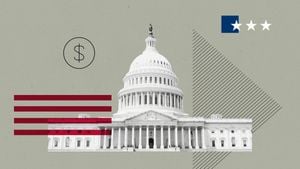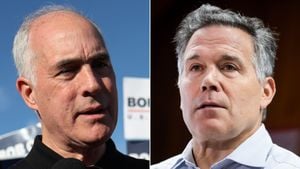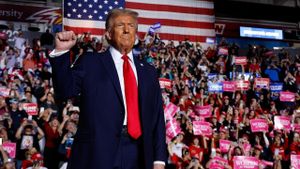With the 2024 presidential election heating up, recent polling data reveals significant traction for former President Donald Trump among swing voters. Particularly notable are the Emerson College surveys highlighting Trump’s edge in key battleground states, such as North Carolina, Pennsylvania, and Wisconsin. These states are pivotal for any candidate aiming to cross the 270 electoral votes threshold needed to claim the White House.
Polling conducted on October 21st and 22nd indicated Trump leading North Carolina with 50% support against Vice President Kamala Harris who stood at 48%. This marginal lead is supported by distinct voter preferences, primarily driven by gender; men favored Trump by 13 points, parsing the electorate along deeply entrenched lines.
Economic issues are particularly pivotal for voters, with two out of five respondents marking finances as their primary concern. This resonates with the current backdrop where inflation and overall economic health occupy center stage in voter minds. Notably, no other issue surpassed 15% priority among respondents, indicating economic anxiety precedes other political issues.
Despite Trump’s momentum, the polling data presents nuanced challenges for the GOP. Ominously for Republicans, the same poll stated Trump’s lieutenant governor candidate, Mark Robinson, showed no substantial lead against Democratic Attorney General Josh Stein, trailing 39% to 51%. A troubling sign for Republicans is the indication of ticket-splitting among Trump voters, with 8% supporting Stein, illuminating potential vulnerabilities within state-level races.
The survey results from Pennsylvania showed Trump barely holding onto his lead, securing 49% against Harris’s 48%, with 3% of voters still undecided. The dynamics shifted considerably once undecided voters were factored; if pushed, Trump would lead by 51% to Harris's 49%. Compounding the complexity for Democrats, 85% of voters had already committed to their candidate preference for more than the previous month, which suggests late-deciding voters often favor Trump.
Age demographics present another decisive factor. Among voters aged 50 and above, Trump’s lead expands to +16, conversely, Harris boasts +18 with the younger electorate, showcasing the generational divide shaping this election. For history buffs, it’s worth recalling the narrow margins of previous contests; Trump won Pennsylvania by less than one percentage point back in 2016 but lost it again by just over one point four years later.
Meanwhile, Wisconsin’s polling results echo similar patterns. Trump leads Harris by a marginal 49% to 48%. Here again, the gender divide is evident, with men supporting Trump by +12 and women backing Harris by +9, marks mirroring Pennsylvania’s split. The Badger State is historically tight, with past elections producing razor-thin margins between candidates and this year appearing no different.
Trump also seems poised to extend his influence beyond just the presidential race. Businessman Eric Hovde is within competitive range against incumbent Democratic Senator Tammy Baldwin, tied at 48% according to the latest polls. This raises the possibility of Trump's candidacy invigoratively influencing other races, potentially aligning the fortunes of Republican candidates across the state.
All these factors lead to speculation about the potential outcomes as Election Day approaches. Current trends suggest Trump is rallying support in key areas of the electorate – particularly male voters who gravitate toward economic issues and societal concerns surrounding immigration, which Trump highlighted during his final campaign push.
Breaking down the dynamics, Trump's last-minute rallies featured him leaning heavily on controversial remarks, reminiscent of his previous campaign style. His rhetoric, noted for its often incendiary nature, included disparaging comments aimed at fellow political figures and alluded to dire outcomes should Harris be successful at the polls. His closing sentences seemed deliberate; veering from substantive policy discussions to provocative crisis framing, possibly intended to galvanize his base.
On the Democratic side, Harris embarked on high-profile rallies, flanked by celebrity endorsements from influential figures like Lady Gaga, Oprah Winfrey, and Katy Perry. These star appearances symbolize the party's attempt to infuse excitement and draw attention to their candidate, countering Trump's strongholds.
Importantly, captivating engagements such as these could sway potential undecided voters but also risk alienation among more traditional voters who may view celebrity involvement unfavorably. Harris’s message prominently asserted her vision for the future, elegantly contrasting Trump's nostalgia-laden campaign themes.
With voters already starting to cast their ballots, the current polling picture promises significant drama on Election Day. Comparatively, the trend indicators suggest uncertainty for Harris as her campaign scrambles to overcome Trump’s presumptive advantages found within current polling data. This political tug-of-war, emphasizing economic concerns and voter demographics, points toward one of the closest races America has seen.
Whether the celebrity-studded events swayed enough undecided voters will be key to watch as Tuesday arrives. The stakes couldn’t be higher, as the narrative continues to evolve leading to the much-anticipated conclusion.
Catchphrases and slogans are only part of this fascinating and deeply consequential political play; the true impacts remain hidden until the votes are tallied. With swing states becoming pivotal chess pieces, their political weight could shift decisively between Harris and Trump. The outcome might shape the broader legislative agenda for years, underscoring the importance of this electoral season.
Until the dust settles and the last votes are counted, speculation will run rife. For now, the race goes on, and interest levels remain at fever pitch.



